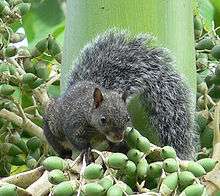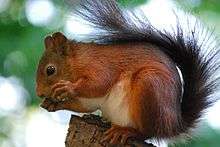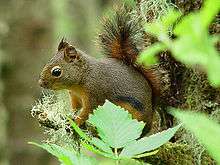Yucatan squirrel
| Yucatan squirrel | |
|---|---|
 | |
| Scientific classification | |
| Kingdom: | Animalia |
| Phylum: | Chordata |
| Class: | Mammalia |
| Order: | Rodentia |
| Family: | Sciuridae |
| Genus: | Sciurus |
| Subgenus: | Sciurus |
| Species: | S. yucatanensis |
| Binomial name | |
| Sciurus yucatanensis (J.A. Allen), 1877 | |
| Subspecies[2] | |
| |
 | |
| Yucatan squirrel's range | |
| Synonyms | |
|
Sciurus carolinensis var. yucatanensis J.A. Allen, 1877 | |
The Yucatan squirrel (Sciurus yucatanensis) is a tree squirrel in the genus Sciurus found in the Yucatán Peninsula and adjacent areas. It is native to northern Belize, northeastern Guatemala, and southeast Mexico.[3][4]
This taxon was originally described as a variety of the grey squirrel as Sciurus carolinensis var. yucatanensis by Joel Asaph Allen in 1877, based on 4 specimens he received from Mérida, Yucatán, collected by A. Schott in 1865. Already in this 1877 publication Allen mused if raising the variety to species rank were not more appropriate, based on the observed distinctiveness. Allen first coined it as the Yucatan gray squirrel.[5] S. yucatanensis ssp. baliolus was published by E. W. Nelson in 1901 based on a specimen from Apazote, Campeche, Mexico.[6] S. yucatanensis ssp. phaeopus was published by George G. Goodwin in 1932 based on 11 specimens collected in Secanquim and Finca Chamá, in Alta Verapaz, in Guatemala.[7]
These squirrels live in dry deciduous and evergreen forests, semiarid pine-oak woodlands, and secondary forest growing in formerly logged areas.[4][8] They are found in lowlands below 750m altitude.[4] They are active during the day and resting at night, spending most of their time in trees.[1] They are most active in the early morning, but may be seen sunning on a branch later in the day.[4] Their dreys (or nests) are built in branches from leaves and twigs. The squirrels eat soft fruit, nuts and seeds according to Best in 1995,[1] Reid in 2009 concludes the main diet consists of flowers, buds, and shoots.[4] Females generally give birth to 2 or 3 young during the April to August dry season.[1]
Three subspecies are recognised:
- S. yucatanensis ssp. yucatanensis (J.A. Allen), 1877 - Found within the end of the Yucatán Peninsula in the Mexican states of Yucatán, southwest to Campeche up to the Champotón Municipality and Quintana Roo, and further south to the northern Belize districts of Orange Walk and Corozal. It has the largest known distribution.[9] It is found in arid woodlands.[6]
- S. yucatanensis ssp. baliolus Nelson, 1901 - Found further southwest from the range of the nominate form in a band across the Yucatán Peninsula from the Champotón Municipality and southwest of the Laguna de Términos in Campeche State and eastern Tabasco State north of the Usumacinta River in Mexico, through northeast Petén Department in Guatemala, to Cayo and Belize districts in Belize.[3][6][10] It is distinguished from the nominate form by virtue of a darker pelage.[6] It inhabits more moist, evergreen woodlands than the nominate form.[6] Nelson coined the name Campeche squirrel for it in 1901.[6]
- S. yucatanensis ssp. phaeopus Goodwin, 1932 - Found at the base of the Yucatán Peninsula from the Mexican states of northwestern and eastern Chiapas east to southern Petén and Alta Verapaz departments of Guatemala and further east along the coast of Belize District in Belize.[7][11] It is distinguished from the other subspecies being the darkest of the three, possessing black legs, tail and at the base of the ears.[7] It was originally found inhabiting pine-oak woodlands at some 366m altitude.[7]
References
- 1 2 3 4 Vázquez, E.; Emmons, L.; Reid, F. & Cuarón, A. D. (2008). "Sciurus yucatanensis". IUCN Red List of Threatened Species. Version 2008. International Union for Conservation of Nature. Retrieved 6 January 2009.
- ↑ Thorington, R.W., Jr.; Hoffmann, R.S. (2005). "Sciurus (Sciurus) yucatanensis". In Wilson, D.E.; Reeder, D.M. Mammal Species of the World: a taxonomic and geographic reference (3rd ed.). The Johns Hopkins University Press. pp. 754–818. ISBN 0-8018-8221-4. OCLC 26158608.
- 1 2 "Sciurus yucatanensis J.A.Allen, 1877". GBIF Backbone Taxonomy - Checklist dataset. GBIF Secretariat. 2017. doi:10.15468/39omei. Retrieved 10 August 2018.
- 1 2 3 4 5 Vázquez, E.; Emmons, L.; Reid, F.; Cuarón, A.D. (2017). "Sciurus yucatanensis (Yucatan squirrel)". The IUCN Red List of Threatened Species. IUCN. Retrieved 10 August 2018.
- ↑ Coues, Elliott; Allen, Joel Asaph (1877). Monographs of North American Rodentia. Washington D. C.: Govt. print. off. p. 705-710. doi:10.5962/bhl.title.16063.
- 1 2 3 4 5 6 Nelson, E. W. (9 August 1901). "Descriptions of Two New Squirrels from Mexico". Proceedings of the Biological Society of Washington. Washington D. C.: Biological Society of Washington. 14: 131. Retrieved 10 August 2018.
- 1 2 3 4 Goodwin, George G. (22 October 1932). "A new squirrel from Guatemala" (PDF). American Museum Novitates (574): 1–2. Retrieved 10 August 2018.
- ↑ Valdés Alarcón, Manuel (November 2003). "Las Ardillas de México" (PDF). Biodiversitas (in Spanish). No. 51. Mexico City: Comisión Nacional para el Conocimiento y Uso de la Biodiversidad. Retrieved 9 August 2018.
- ↑ "Sciurus yucatanensis subsp. yucatanensis J.A.Allen, 1877". GBIF Backbone Taxonomy - Checklist dataset. GBIF Secretariat. 2017. doi:10.15468/39omei. Retrieved 10 August 2018.
- ↑ "Sciurus yucatanensis subsp. baliolus Nelson, 1901". GBIF Backbone Taxonomy - Checklist dataset. GBIF Secretariat. 2017. doi:10.15468/39omei. Retrieved 10 August 2018.
- ↑ "Sciurus yucatanensis subsp. phaeopus Goodwin, 1932". GBIF Backbone Taxonomy - Checklist dataset. GBIF Secretariat. 2017. doi:10.15468/39omei. Retrieved 10 August 2018.



